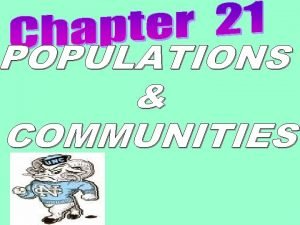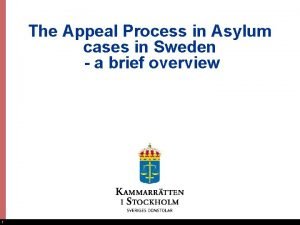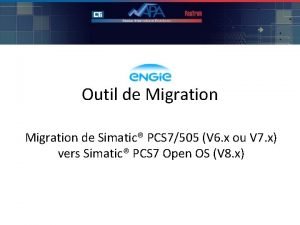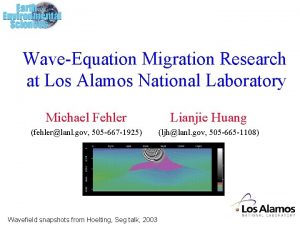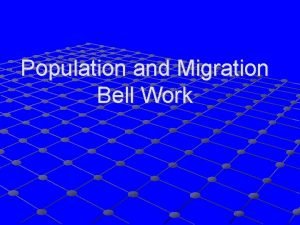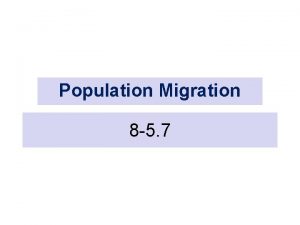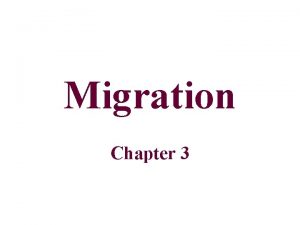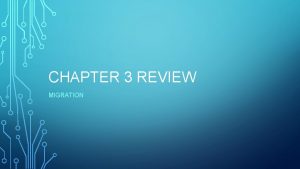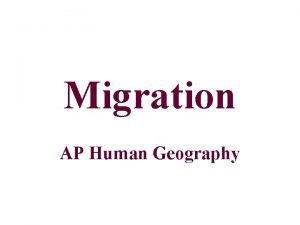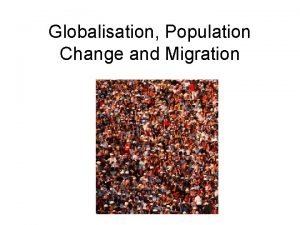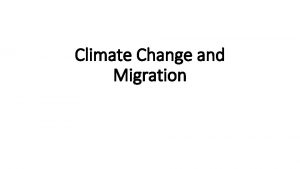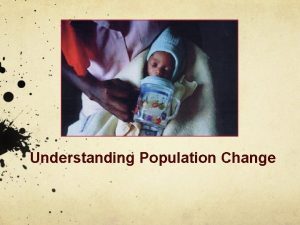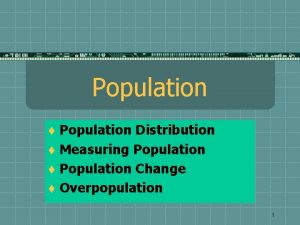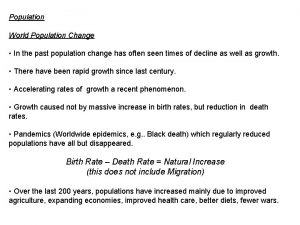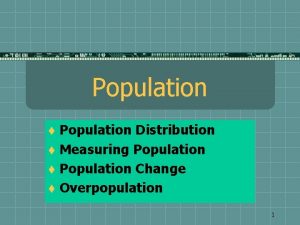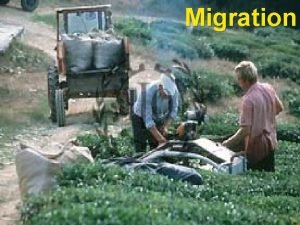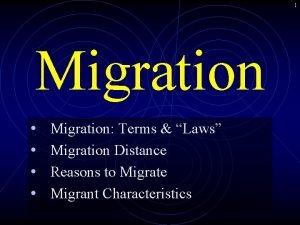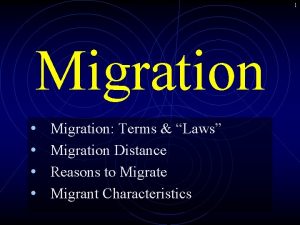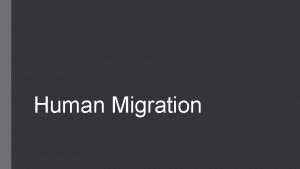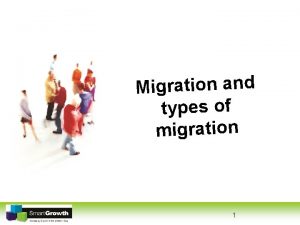Population change 3 Migration 1 1 What is





























- Slides: 29

Population change 3 Migration

1. 1 What is demographic change? • The net change in the population store caused by the inputs of births and in-migration and the outputs of death and out-migration. • Global population growth, totals, distribution and density. 1. 2. How and why do populations change naturally? • A study of countries at Stages 2 -5 of the demographic transition to demonstrate variations in fertility and mortality rates, including infant mortality and life expectancy. 1. 3 What is the role of migration in population change? • Characteristics of different types of migration. • The economic, social and environmental impacts of migration on exporting and receiving countries/regions. 1. 4 What are the issues of the migration of refugees and asylum seekers? • The causes and consequences of flows of refugees and asylum seekers into developed economies both from a historical and current dimension. • Housing. • Repatriation. • The attitudes and values of migrants and hosts. • Human rights.

1. 5 What are the causes and impacts of changing gender structures? • Changing gender structures in populations as countries pass through the demographic transition. • Social, economic and political impacts of gender structures. 1. 6 What are the demographic challenges facing countries? • The demographic causes and effects of ageing societies including issues such as dependency, workforce and pensions. • The issues of high birth rates and high mortality rates – including AIDS. • Policies to alleviate the ‘demographic challenges’

Definition • Population moves from one administrative area to another • The result of a change of address for a year or more Circulation = commuting, • All others are types should be termed ‘Circulation’ pastoral nomadism, United Nations holiday-making Migration – of humans, a movement from area (usually the home area) to work or settle in another The Penguin Dictionary of Geography – A. N. Clark Permanent or semi-permanent change of residence of an individual or group of people The Dictionary of Human Geography – R. J. Johnston

Motives • The Push and Pull factors • 5 categories 1. 2. 3. 4. 5. Physical Demographic Economic Social Political People are pushed by adverse conditions (e. g. overpopulation, poverty, political repression, war, dislike of a development scheme) to leave an area, and are at the same time attracted to another area by what are perceived as favourable conditions (e. g. the likelihood of a better job, higher wages, freedom of movement) in that area

Types • The Scale (Regional, National, International) • The Cause (Forced or Voluntary) • The Area (Rural to Urban, LEDC-MEDC)

Forced Migration • Religious or political persecution, war, natural disaster, forced labour or famine

Voluntary • • Climate Employment Family Better services

Internal Migration = • • • Migration within countries Moving house Urban to urban Urban to rural Rural to urban Such as Pioneer advances across USA 1800’s +

International Migration • Voluntary • Colonisation of countries such as the USA up to around 1924 • Most is now forced due to the tightening of immigrant policies

Area • LEDC to MEDC (West Indies to UK in the 20 th century • LEDC to LEDC – refugees moving because of wars (Africa, Rwanda, Mozambique) • MEDC – MEDC (Brain drains) • MEDC – LEDC (Missionaries, charity workers, explorers, penal settlements)

Models of Migration • • • Gravity model Lee’s Model Ravenstein’s model Stouffer’s intervening opportunity model Zelinsky’s Mobility Transition Theory

Newton’s Gravity model This model was developed from the scientific work of Isaac Newton who noticed that the force of gravity decreased with distance. This was applied to migration by EG Ravenstein in the 1880 s and further developed by Zipf in 1946. The number of people moving from between places A and B is equal to the population of A multiplied by the population of B and divided by the square of the distance between them. A x B____ Distance² Not a particularly successful model

The gravity model is highly simplified since it assumes that each migrant has the same information available and that migration costs are the same in all directions. The decision making process of each migrant is reduced to distance only, whereas obviously there are many other factors to consider.

Stouffer's law of intervening opportunities (1940) • • the amount of migration over a given distance is directly proportional to the number of opportunities at the place of destination, This is inversely proportional to the number of opportunities between the place of departure and the place of destination. The intervening opportunities may persuade a migrant to settle in a place en route rather than proceeding to the originally planned destination. Stouffer argued that the volume of migration had less to do with distance and population totals than with the opportunities in each location.

Lee’s Model 1966

• • • Does not isolate push pull factors Looks at attributes for each place Decisions based on personal factors reliant on 1. 2. 3. 4. 5. Age Gender Marital Status Education Socio-economic class • Some are positive factors, some are seen as negative, others as neutral, and all these influence the personal decision making process

• Lee’s model introduces a refinement to push pull factors • Intervening Obstacles Both real or perceived • International boundaries, language, anxieties etc.

Ravenstein's Migration Laws (1870's 1880's) • • Most migrants go only a short distance (gravity law) Longer-distance migration favours big-city destinations Most migration proceeds step by step Most migration is rural to urban Each migration flow produces a counter flow (i. e. return to place of birth) Most migrants are adults--families are less likely to make international moves Most international migrants are young males Ernst George Ravenstein was a German geographer who moved to England researched census data from the 1881 census. His findings led him to propose the above ‘laws’ as general patterns of migration.

Two way Nature of Migration • Often movement in population between two places is both ways, but unequal • The stronger one is called Dominant • The weaker is the reverse or counter migration • The Total volume is called the Gross Interchange whilst the difference is the Net Migration Balance e. g. Pakistan to UK 1997 6000 Pakistanis entered the UK 2000 Pakistanis returned to Pakistan.


Stepwise migration model This model was developed from Ravenstein’s laws showing that many migrants move in a series of steps.

Clark’s Behavioural Model This model concentrates more on the reasons an individual has for migrating. These include internal factors (the person’s needs) and external factors (the local environment and community) which affect the person’s decision.

Zelinsky’s model of mobility transition This theory parallels the demographic transition model defining major changes in migration type over time from the pre-industrial to the advanced industrial society.

Differential Migration • • 1. 2. 3. 4. • • Based on the principle that some people are more likely to migrate than others Significant factors include: Age Gender Education Occupation In most countries young males seem the most migratory Gender depends on the country’s development In LEDC’s men make up the majority of migratory streams Education has a direct bearing on occupation and therefore possibly mobility. Professionals are more migratory than unskilled.

Consequences of Migration

Demographic Consequences • Changes in the numbers and distribution of people within a region are changed. • Intermarriages are created, leading to a new group of people.

Social Consequences • Migration brings different people together leading to conflicts. • Migration however also creates understanding between different groups of people. • Rural-Urban migration creates ghettoes in cities.

Economic Consequences • This depends on the "quality" of the migrants and the economic needs of the origin and destination. Quality refers to skills, age, educational attainment, health etc. • In overpopulated areas, emigration is beneficial because it reduces the pressure on the land. • In underpopulated areas, emigration may slow down development. SOLVING IMMIGRATION / PROBLEMS OF IMMIGRATION • http: //www. geographyalltheway. com/ib_geography/ib_population/popn _movement. htm
 Population ecology chapter 4 answers
Population ecology chapter 4 answers Chapter 4 population ecology test answer key
Chapter 4 population ecology test answer key Population ecology section 1 population dynamics answer key
Population ecology section 1 population dynamics answer key Population ecology section 1 population dynamics
Population ecology section 1 population dynamics Absolute change and relative change formula
Absolute change and relative change formula Chemical change in baking
Chemical change in baking Change in supply and change in quantity supplied
Change in supply and change in quantity supplied Rocks change due to temperature and pressure change
Rocks change due to temperature and pressure change Spare change physical versus chemical change
Spare change physical versus chemical change Integers definition
Integers definition First-order change and second-order change examples
First-order change and second-order change examples Change your water change your life
Change your water change your life Is painting a wall a physical change
Is painting a wall a physical change Whats chemical change
Whats chemical change Is rocket fuel burning a physical change
Is rocket fuel burning a physical change Is chopping wood physical or chemical
Is chopping wood physical or chemical Proactive vs reactive change
Proactive vs reactive change Example of chemical and physical change
Example of chemical and physical change Physical change
Physical change Change in supply vs change in quantity supplied
Change in supply vs change in quantity supplied Climate change 2014 mitigation of climate change
Climate change 2014 mitigation of climate change Physical and chemical changes examples
Physical and chemical changes examples Energy roles
Energy roles Migration court of appeal stockholm
Migration court of appeal stockholm Radial and tangential migration
Radial and tangential migration Migration
Migration Ca workload automation de
Ca workload automation de Mga sinaunang pilipino
Mga sinaunang pilipino Simatic migration tool
Simatic migration tool Migration
Migration






















